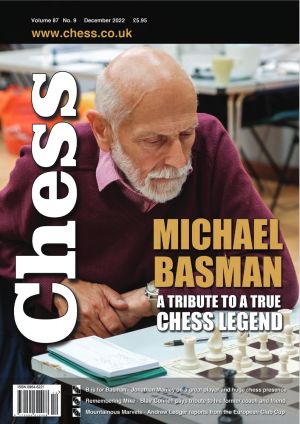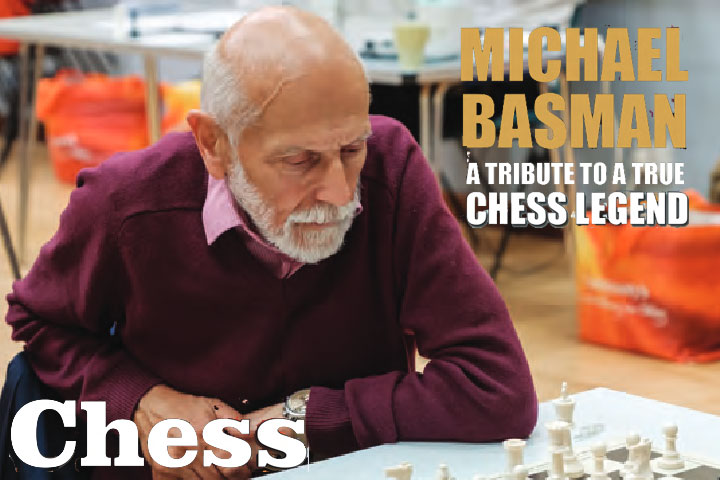Throughout the 1970s Michael Basman developed a playing style so distinctively baroque and otherworldly that it turned into a brand. ‘Basmanic’ quickly became a byword for boldly eccentric opening play, at roughly the same time as ‘Karpovian’ entered chess parlance to describe the patient accumulation and conversion of small positional advantages. It is hard to think of another player in recent times whose name has coined a style. Michael’s name fortuitously anagrammed to ‘Shamble Maniac’, which handily blessed his reputation for reckless invention.
J.Speelman-M.Basman, British Championship, Brighton 1980, Basmaniac Defence
1 e4 g5 The 2,000 page FIDE Encyclopaedia of Chess Openings does not mention this move at all. However, Basman has adopted it on a number of occasions with success. His secret, perhaps, is that the move is not quite as bad as it looks. 2 d4 h6 3 h4 gxh4 4 Îxh4 d5
Basman commented on this move: “This is to bust the position open and tear his king limb from limb.” This is the way he talks. Is it the way he thinks? – Murray Chandler & Ray Keene, The English Chess Explosion: From Miles to Short (Batsford, 1980), p.102
This was also the year Tony Miles famously defeated Karpov with the Basmanic 1...a6!? in the European Teams Championship at Skara.
I first met Mike in 1986 at the British Championships in Southampton. I was there to hawk a chess magazine I had launched and to gather material for it; and I was keen to seek a contribution from the Grobmeister, the mischievous uncle of English chess. As well as being a leading player, he had built a reputation as a fine chess teacher and a funny writer through his own magazine, Popular Chess, and his innovative Audio Chess cassette series (there were already over 100 cassettes covering openings, endings and positional play, including a few spoofs).
Luckily we were paired in a rapidplay tournament organised alongside the main event and after the game I plucked up the courage to ask him if he might be interested in doing something for Kingpin. He said he might if he thought any of his games in the British were worth writing up. They were. A couple of weeks later he sent me three annotated games from his British Championship – three acts of a Greek tragedy.
What is striking about these games is how each highlights different aspects of his playing style. As you might expect, there is his calling card – the outlandish opening 1 e4 g5 (“Totally bonkers” – Nigel Short); but next is a tricky rook, bishop and pawn versus rook ending – where Mike heroically struggles to win a position he had reached before (and only drawn) against William Hartston. Then comes the final act, a tragic loss to Murray Chandler in the last round after a promising start: “The opening begins ‘normally’; but after 10 moves we are in a position unknown to man.”
The article is typical of his clear, open and joyful approach to popularising chess. He focuses on simple explanations rather than variations, the critical moments, vivid analogies, and on-the-spot details to give you the impression you are at the board reliving the game with him. The agony and the ecstasy of chess wryly observed by one of the game’s most freethinking players. See www.kingpinchess.net for the whole drama.
Mike also wrote for Kingpin about his early forays into cheating at chess. These self-mocking confessions are among the most popular pieces on Kingpin’s website. Several years ago he had suggested another article, about his most eventful year in chess. This was 1973, the year he tied for first in the British Championship (losing the play-off to Hartston), and almost died in a car crash. Sadly, despite my encouragement he never managed to complete it.
 An 18-year-old Mike Basman at the Stevenson Memorial Tournament, Bognor, April 1964.
An 18-year-old Mike Basman at the Stevenson Memorial Tournament, Bognor, April 1964.
The game recalls what Wilhelm Steinitz wrote of Mike’s hero, the Victorian master Henry Bird, also famed for his stubborn loyalty to dubious openings:
“Few chess masters could excel Mr. Bird in rapid survey of position and in the formation and execution of surprising manoeuvres, which, although not always sound – and sometimes, as he admits, even eccentric – tend to raise confusing complications, difficult for the adversary to disentangle at a quick rate.” – The Field, 30th December 1879.
So long Mike, and thanks for all the fun.
The Best of Basman
Mike Basman was renowned for his keen and deadly tactical eye, as well as his creativity. Can you find spot what he did in these positions? On the first diagram, the engine will defend for the black pieces. On the rest you can start and engine to analyse.
And here are all the games – and the solutions:
About CHESS Magazine

The above feature is reproduced from Chess Magazine December/2022, with kind permission.
CHESS Magazine was established in 1935 by B.H. Wood who ran it for over fifty years. It is published each month by the London Chess Centre and is edited by IM Richard Palliser and Matt Read.
The Executive Editor is Malcolm Pein, who organises the London Chess Classic.
CHESS is mailed to subscribers in over 50 countries. You can subscribe from Europe and Asia at a specially discounted rate for first timers, or subscribe from North America.
Also read: Diana Mihajlova's obituary on Michael Basman (1946 - 2022)

























